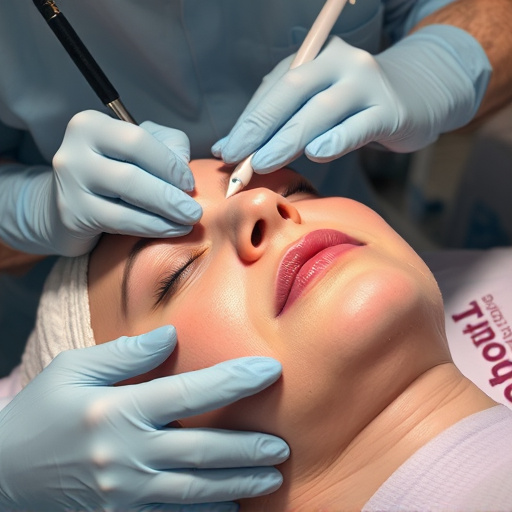Melasma, or 'mask of pregnancy,' is a skin condition characterized by dark patchy pigmentation, primarily affecting women during or after pregnancy due to hormonal and environmental factors. Traditional treatments have limited success, but modern approaches like laser hair removal, microneedling, and customized facials are gaining popularity for their gentle yet effective targeting of melasma. The melasma treatment landscape has evolved significantly with advanced laser technologies, offering safer, non-invasive solutions that target specific melanin-producing cells, improve skin tone, and minimize recovery time. Laser procedures provide remarkable results in skin tightening and pigment regulation, making them a popular choice at medical spas.
Melasma, often dubbed the ‘mask of pregnancy,’ is a common skin condition characterized by dark patches on the face. While it can be challenging to treat, laser technologies are emerging as a revolutionary solution. This article explores how advanced laser treatments are transforming melasma care. We delve into understanding this condition, its causes, and the challenges faced in treatment. Subsequently, we uncover the benefits and outcomes of using lasers for melasma, highlighting their growing importance in skincare.
- Understanding Melasma: Causes and Challenges
- The Rise of Laser Treatments for Melasma
- Unlocking the Potential: Results and Benefits
Understanding Melasma: Causes and Challenges

Melasma, often referred to as ‘mask of pregnancy,’ is a common skin condition characterized by dark, patchy pigmentation on the face, typically affecting women during or after pregnancy. While it is generally harmless, melasma can be aesthetically distressing, leading many to seek effective melasma treatment solutions. Understanding its causes is crucial in navigating suitable care options. This hyperpigmentation results from an overproduction of melanin, triggered by various hormonal changes and environmental factors. Sun exposure plays a significant role, as UV rays stimulate melanocytes, the cells responsible for melanin production.
The challenge lies in addressing melasma without causing further irritation or damage to the skin. Traditional methods like chemical peels and topical creams often have limited success, especially with persistent use. Moreover, certain treatments can exacerbate hyperpigmentation if not managed carefully. As such, modern approaches like laser hair removal, microneedling therapy, and customized facials are gaining traction for their targeted and gentle effects on melasma treatment, offering hope for a clearer, more even complexion.
The Rise of Laser Treatments for Melasma

In recent years, the landscape of melasma treatment has undergone a remarkable transformation with the advent of advanced laser technologies. What was once a complex and often frustrating journey for patients struggling with this disfiguring skin condition, is now being revolutionized through targeted and highly effective laser treatments. The growing demand for safe and non-invasive solutions has prompted dermatologists to explore the potential of lasers as a game-changer in melasma management.
Laser hair removal, while not directly related to melasma treatment, has inadvertently contributed to this progress by fostering advancements in laser technology. Innovations in laser energy delivery systems have allowed for more precise targeting of skin pigmentation issues, including melasma. Acne treatments have also benefited from these developments, as many lasers now dual-purpose, addressing both acne scars and hyperpigmentation associated with melasma. Moreover, the focus on skin brightening has further driven research into laser therapies, offering hope for a more even and radiant complexion for those affected by melasma.
Unlocking the Potential: Results and Benefits

Melasma treatment has entered a new era with laser technologies at the forefront, offering unprecedented potential for those seeking effective solutions. These advanced treatments go beyond conventional methods, providing remarkable results in skin tightening and pigment regulation. By targeting specific melanin-producing cells, lasers can reduce hyperpigmentation and even out skin tone, addressing the root cause of melasma.
The benefits extend far beyond aesthetic improvements. Laser treatments are highly precise, minimizing damage to surrounding healthy skin, making them a safer option compared to some topical creams or surgical procedures. Moreover, they offer a non-invasive approach, reducing recovery time significantly. Many individuals find that regular sessions at medical spas can lead to long-lasting results, improving their overall skin health and confidence in managing melasma. This revolutionary shift in melasma care is transforming the way we think about skin rejuvenation, with laser hair removal being one of the most sought-after procedures alongside other medical spa services.
Laser treatments are emerging as a promising solution for melasma care, offering targeted and effective results. By addressing the underlying causes, these advanced procedures provide a non-invasive approach with minimal downtime, revolutionizing the way we manage this complex skin condition. With ongoing advancements in laser technology, individuals seeking melasma treatment can now experience improved skin clarity and confidence.














